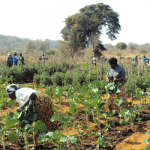The fall armyworm is a destructive pest that primarily attacks maize (corn) crops but can also infest over 80 other plant species, including rice, sorghum, and vegetables.
LOSSES CAUSED BY FALL ARMYWORM
The losses and damages caused by fall armyworm in maize can vary depending on factors such as the severity of the infestation, the stage of crop growth, and the effectiveness of pest management strategies. They include:
Yield Reduction: Fall armyworm larvae feed voraciously on maize plants, causing significant damage to the leaves, tassels, and kernels. This feeding damage can lead to reduced yields per hectare.
Quality Reduction: Feeding damage can affect the quality of maize kernels, reducing their market value. Damaged kernels may also be more susceptible to fungai infections and mycotoxin contamination, further reducing their quality and safety.
Increased Production Costs: Farmers may incur additional costs for pest management strategies such as insecticide applications, biological control methods, or cultural practices to mitigate fall armyworm infestations. These increased production costs can impact farm profitability.
Crop Loss: In severe infestations, fall armyworm can cause complete defoliation of maize plants, leading to crop loss. This not only affects farmers’ income but also contributes to food insecurity at the local and national levels.
Secondary Pest Outbreaks: Intensive pesticide used to control fall armyworm can disrupt the natural balance of insect populations, leading to outbreaks of secondary pests or the development of pesticide resistance in fall armyworm populations.
CONTROL OF FALL ARMYWORM
Effective control and management of fall armyworm (FAW) in maize typically involves a combination of approaches:
Biological Control: Introduce natural enemies of fall armyworm such as parasitic wasps, predators like ladybugs and spiders, and pathogens like certain strains of bacteria and fungi.
Cultural Practices: Rotate crops to disrupt the life cycle of fall armyworms, plant trap crops to attract them away from main crops, and practice good sanitation to reduce overwintering sites.
Mechanical Control: Handpicking larvae, destroying egg masses, and using physical barriers like row covers can help reduce fall armyworm populations.
Chemical Control: Insecticides can be used as a last resort, but they should be applied judiciously to minimize harm to beneficial insects and the environment. Follow recommended application rates and timings.
Biotechnological Approaches: Developing maize varieties resistant to fall armyworm through genetic engineering or traditional breeding can provide long-term solutions.
Monitoring and Early Detection: Regular scouting of maize fields to detect fall armyworm infestations early allows for timely intervention before populations become too large.
“COMMUNITY ENGAGEMENT” :
Educating farmers about fall armyworm identification, monitoring techniques, and control measures can empower them to manage infestations effectively at the local level.
Emmanuel John Fatona JFC
““The Young Erikina agri-food farmer
He can be reached on 08140832716 or emmanueljohnfatona@gmail.com.
EDITOR’S NOTE:
With this entry Mr. Fatona commences a weekly column with us on this site. In his column he will look at the challenges farmers face on the job and proffer solutions to them. Our reading audience can also reach out to him through his email address or send WhatsApp messages only to the telephone number indicated under his name.












